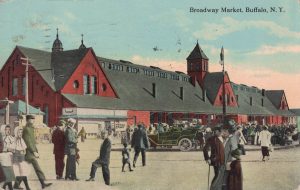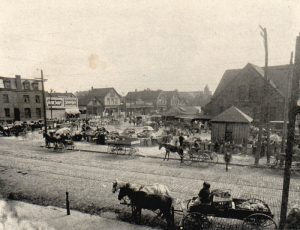After St. Stanislaus was established in 1873, a bustling Polish neighborhood developed in East Buffalo. To feed this populace, thousands of women made a journey to the Washington Street Market about two miles away. Because this trek was hard on the Poles, a push was made to build a market more centrally located for them. After a petition with 1,000 signatures was presented to the Buffalo City Council in favor of a market on Broadway, the Council Committee on Markets began looking for a prime location. After a number of proposals and debates, a location was found in 1888 and the outdoor market was born. It would take two years but on March 24, 1890, the market was formally opened with a full lineup of German, English, Polish, and Jewish vendors and the Poles began to shop.
 On December 20th 1890, a writer from the Buffalo Evening News went to the market to report on the Christmas business. Many of the vendors called the market “a howling success…[t]hese Polish women never ask for credit and that is what we like about them.” From this first year, the market grew as a gathering place for 90% of the Polish community around it. In the free land of America, these formerly oppressed people treated the Broadway Market as a Roman Forum where they could discuss anything including politics and soon they had formed into a sizable political base.
On December 20th 1890, a writer from the Buffalo Evening News went to the market to report on the Christmas business. Many of the vendors called the market “a howling success…[t]hese Polish women never ask for credit and that is what we like about them.” From this first year, the market grew as a gathering place for 90% of the Polish community around it. In the free land of America, these formerly oppressed people treated the Broadway Market as a Roman Forum where they could discuss anything including politics and soon they had formed into a sizable political base.
By 1900, the power of Buffalo’s Polish vote was known to national leaders. To reach this group, where they were most comfortable presidential candidates, William Jennings Bryant and Teddy Roosevelt both arranged for rallies to be held at the Broadway Market. By the time of these rallies part of the market’s makeup was changing. The vendors for the most part remained English, Jewish, and German, but more Poles began to rent stands. Into the 1920s the market began to have a more distinct Polish flavor. Polish religious and civic events were held on the property including a Roman Catholic Mass at the market and events celebrating the formation of the Polish Army. Even with the Polish-themed events held at the market, it was still a city market with a diverse clientele, but with strong Polish overtones.
 At the end of World War II, the 56-year-old market began to look her age and in 1956 a new market building was opened. Looking to recoup the cost of the market the city began charging for parking on a new ramp, but the number of customers driving from West Seneca, Cheektowaga, and Amherst weren’t offsetting the cost. By 1968, the city wanted to get out of the market business and a newly-formed Buffalo Broadway Market Merchants Corporation was set up to take over the operation of the market in 1969. With the city out, the corporation was allowed to shape the market as it saw fit, and they envisioned a Polish market.
At the end of World War II, the 56-year-old market began to look her age and in 1956 a new market building was opened. Looking to recoup the cost of the market the city began charging for parking on a new ramp, but the number of customers driving from West Seneca, Cheektowaga, and Amherst weren’t offsetting the cost. By 1968, the city wanted to get out of the market business and a newly-formed Buffalo Broadway Market Merchants Corporation was set up to take over the operation of the market in 1969. With the city out, the corporation was allowed to shape the market as it saw fit, and they envisioned a Polish market.
This change in tone reinforced Polish ideals held by the now second, third, and fourth generation Polish Americans shopping at the market. The generational change led to a geographic change with over 60% of the shoppers coming in from the suburbs. Soon these suburbanites began to see the market as a Polish tradition, creating an Easter pilgrimage the Broadway Market would be known for. Today Easter Week fills the market with customers looking for Polish sausage, bread, horseradish, and butter lambs for their Easter basket, perpetuating traditions that extend back over 100 years.
Do you have any stories or memories about this location of the Polonia Trail? We would love to hear it! Please send us your story, and if it is chosen, it will be added to the site.
Send Your Story